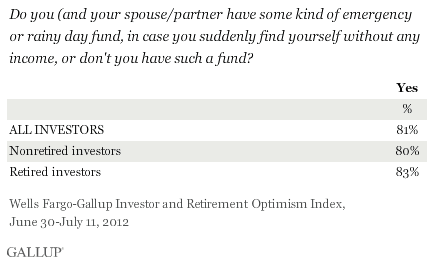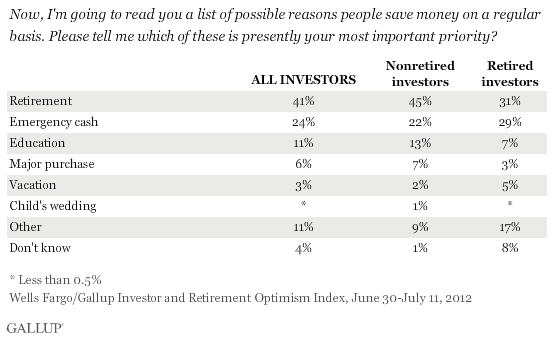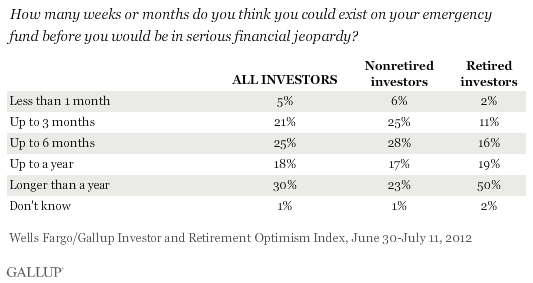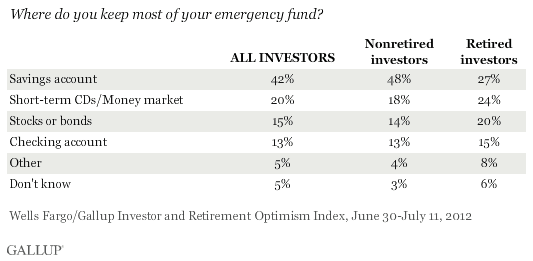PRINCETON, NJ -- The vast majority of American investors say they have an emergency fund they can use in case they suddenly find themselves without income. Retired (83%) and nonretired (80%) investors are about equally likely to report having such a fund, according to the June 30-July 11 Wells Fargo-Gallup Investor and Retirement Optimism Index survey.

The survey is conducted quarterly with Americans who have $10,000 or more of investable assets. Roughly 40% of American adults meet this definition.
Emergency Funds Place Second Among Reasons to Save Regularly
While nonretirees and retirees are most likely to say saving for retirement is their top priority, building an emergency fund comes in second among both groups. Forty-one percent of all investors say their most important priority for saving on a regular basis right now is retirement, with 31% of those already retired continuing to do so. Building an emergency fund comes in second, with 24% of all investors -- including 22% of nonretirees and 29% of retirees -- saying it's their top saving priority.

Half of Investors Say Emergency Fund Will Last Six Months or Less
While most investors have an emergency fund, about half of those who have such a fund say they could exist six months or less on this money before they would be in serious financial jeopardy. Another 18% say they could last up to a year. Half of retirees who have such a fund could last more than a year, while 23% of nonretirees say they could last that long.

Most Hold Their Emergency Fund in Highly Liquid Assets
Almost by definition, an emergency fund must be relatively easy to use immediately without significant penalty. The favorite place for investors to keep "most of" their emergency fund is in a savings account, at 42%. Another 20% keep most of their emergency money in short-term CDs or money markets. Fifteen percent hold their emergency funds in stocks or bonds.

Implications
One difficult lesson of the financial crisis is that when property values are plunging and jobs are disappearing, credit tends to dry up. That is, credit lines make a lousy source of emergency funds since they tend to disappear when most needed. Given that unemployment in the U.S. remains above 8% and underemployment is at about twice that level, and many more Americans are worried about losing their jobs, it is not surprising that investors who can do so are building real emergency funds -- cash or cash equivalents -- just in case the economy suddenly worsens.
In one sense, a stronger and more liquid investor balance sheet is good for the economy. Stronger balance sheets make consumers more credit-worthy over time and provide a substantial financial base for the overall economy. On the other hand, building emergency funds means less investor spending in the immediate term -- something that is not good for consumer spending overall or for short-term economic growth. Regardless, the good news is that when investors do feel confident enough to start spending more aggressively -- perhaps after the election and after the fiscal cliff issues are resolved -- there is the potential for rapid economic growth.
Survey Methods
The Wells Fargo-Gallup Investor and Retirement Optimism Index results are based on questions asked on the Gallup Daily tracking survey from June 30-July 11, 2012, of a random sample of 1,020 U.S. adults having investable assets of $10,000 or more. For results based on the entire sample of national adults, one can say with 95% confidence that the maximum margin of sampling error is ±3 percentage point.
For results based on the sample of 625 nonretirees, one can say with 95% confidence that the maximum margin of sampling error is ±4 percentage points. For results based on the sample of 400 retirees, one can say with 95% confidence that the maximum margin of sampling error is ±5 percentage points.
Interviews are conducted with respondents on landline telephones and cellular phones, with interviews conducted in Spanish for respondents who are primarily Spanish-speaking. Each sample includes a minimum quota of 400 cell phone respondents and 600 landline respondents per 1,000 national adults, with additional minimum quotas among landline respondents by region. Landline telephone numbers are chosen at random among listed telephone numbers. Cell phone numbers are selected using random-digit-dial methods. Landline respondents are chosen at random within each household on the basis of which member had the most recent birthday.
Samples are weighted by gender, age, race, Hispanic ethnicity, education, region, adults in the household, and phone status (cell phone only/landline only/both, cell phone mostly, and having an unlisted landline number). Demographic weighting targets are based on the March 2011 Current Population Survey figures for the aged 18 and older non-institutionalized population living in U.S. telephone households. All reported margins of sampling error include the computed design effects for weighting and sample design.
In addition to sampling error, question wording and practical difficulties in conducting surveys can introduce error or bias into the findings of public opinion polls.
For more details on Gallup's polling methodology, visit www.gallup.com.
